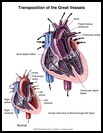
Transposition of the Great Vessels
What is transposition of the great vessels (TGV)?
Transposition of the great vessels (TGV) means that the positions of the 2 main arteries of the heart are reversed from normal.
The two main arteries of the heart are:
- The pulmonary artery, which carries oxygen-poor blood from the heart to the lungs.
- The aorta, which carries oxygen-rich blood from the heart to the rest of the body.
If these arteries are reversed, oxygen-poor blood goes to the body. The blood that already has oxygen is carried back to the lungs.
Babies born with TGV can stay alive only if they have 1 or more other defects that allow the oxygen-poor blood and the oxygen-rich blood to mix until they can have surgery. These defects are:
- a hole between the 2 upper chambers of the heart (atrial septal defect)
- a hole between the 2 lower chambers (ventricular septal defect)
- a blood vessel connecting the lung artery with the aorta (patent ductus arteriosus).
How does it occur?
The cause of this birth defect is not known.
What are the symptoms?
Babies with TGV look blue right after birth. This is because their body is not getting enough oxygen-rich blood.
How is it diagnosed?
Your provider uses an oxygen monitor on the baby’s hand or foot to measure the oxygen level. The baby will have an echocardiogram. An echocardiogram is a test that uses sound waves to make pictures of the heart. This test shows if the pulmonary artery and the aorta are reversed.
How is it treated?
TGV may be treated in stages.
- The first procedure is an atrial septostomy. This procedure uses a catheter (small tube passed through a blood vessel) to create or enlarge an opening between the 2 upper chambers of the heart.
- Sometimes a medicine is given to enlarge or open the small tube between the aorta and the pulmonary artery. The medicine will work only for a short time.
The 2 types of surgery used to correct the problem are:
- Arterial switch. In this procedure, the arteries are switched to the proper positions. This procedure must be done within the first few days or weeks after birth.
- Intra-atrial baffle. This procedure creates a tunnel inside the upper chambers of the heart to route blood to the correct areas. This surgery is usually done in early infancy.
If there are other defects along with TGV, other kinds of surgery may be needed.
How long will the effects last?
Children who have had successful surgery generally lead normal, healthy lives. However, they may still have some heart problems. They will need to visit a specialist in congenital heart disease at least once a year for the rest of their lives.
Ask your healthcare provider if your child should take antibiotics to prevent infection before having dental work or procedures that involve the rectum, bladder, or vagina.

